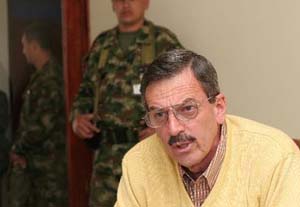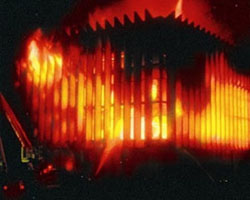Updated - October 28, 2009
Secrets and Lies: The U.S. Embassy and Col. Plazas Vega
By Michael Evans
[The following article was published today in Spanish at Semana.com.]
 |
Col. Luis Alfonso Plazas Vega (ret.) [Photo: Revista Semana] |
|
The recent appearance of a declassified U.S. Embassy report blaming the Colombian Army and Col. Luis Alfonso Plazas Vega for deaths and disappearances during operations to retake the Palace of Justice building in November 1985 has stirred up heated debate on both sides of the issue. As it happens, both sides have it wrong, at least in part. As the person who first uncovered the document, the result of a declassification request to the U.S. State Department, I submit the following points for the sake of clarification and in the hope that the real significance of the document is not lost in the confusion of the moment.
Initial reports on the matter dramatically mischaracterized the document and distorted its meaning. El Espectador, for example, attributed the information to supposed “intelligence agents at the service of the U.S. Embassy in Colombia” and reported that the document had been “brought to the attention of Colombian authorities in 1998”, details that the document simply does not support. Since El Espectador also failed to publish the document itself, many other Colombian news organizations simply followed its lead, repeating the same erroneous details.
Seizing the opportunity, defenders of Col. Plazas have sought to discredit the entire document, including what are by far the most important, verifiable and incriminating details. Pouncing on these inaccuracies in a letter to the editor, the colonel’s wife, Thania Vega de Plazas, said that the original report in El Espectador was “completely false” and went on to invent some facts of her own. Her assertion that the document is merely a summary of “the affirmations of some Colombian human rights NGOs” is 100 percent wrong and a gross mischaracterization of the document. (The colonel’s son, Miguel Plazas, made the same points, in the exact same words, in a letter to El Tiempo.)
She is correct that the document is not primarily about the Palace of Justice case or Col. Plazas. Rather, it is a report that mentions Col. Plazas in another context altogether: his participation in a January 1999 meeting between members of the Colombian Armed Forces and local human rights organizations—one of a series of gatherings meant to bridge the divide between the two groups. A U.S. Embassy representative (“Poloff” for Political Officer) also attended the meeting, hence this cable.
Declassified records are tricky things. It is not always easy to determine the provenance or meaning of a particular document, especially when parts have been redacted. Nevertheless, the meaning of the passage concerning Col. Plazas is unambiguous:
The presence among the “NGO representatives” of two military officers (one active duty, one retired), who killed time with lengthy, pro-military diatribes, also detracted from the military-NGO exchange. One of the two was retired Colonel Alfonso Plazas Vargas [sic], representing the “Office for Human Rights of Retired Military Officers.” Plazas commanded the November, 1985 raid on the Supreme Court building after it had been taken over by the M-19. That raid resulted in the deaths of more than 70 people, including eleven Supreme Court justices. Soldiers killed a number of M-19 members and suspected collaborators hors de combat, including the Palace’s cafeteria staff.
It is not entirely clear on the basis of what evidence the Embassy made these statements about the Palace of Justice case, or why the cable’s author chose to include them here. And it certainly is not possible to determine whether the information was ever brought to the attention of the Colombian authorities, as the report in El Espectador disingenuouslyclaimed. But to attribute these statements to Colombian human rights groups, and to deny that they represent the view of the U.S. Embassy, is simply wrong. Anyone with a working knowledge of the English language can clearly see the meaning of these words.
This brief description of Col. Plazas represents the clearest and most concise statement yet declassified about the Army's responsibility for the deaths and disappearances in the Palace of Justice case. It is extremely unlikely that the Embassy would make such accusations, however tangential they may be to the central subject of the document, without carefully evaluating the available evidence.
While it is appropriate for the defenders of Col. Plazas to question the hyperbolic and in some cases fabricated information that has appeared in some of the reporting on this matter, such objections do not justify the fabrication of equally erroneous information and cannot refute what is plainly evident in the document: that the U.S. Embassy, in January 1999, under Ambassador Curtis Kamman, believed that the Colombian military, under the command of Col. Plazas, was responsible for the vast majority of the deaths and disappearances in the Palace of Justice case.
Any further questions about the meaning of the document or the information therein should be directed to the U.S. State Department. With the case against Col. Plazas moving through the Colombian courts, and with the Truth Commission on the Palace of Justice in its final months, now is the time for the U.S. Government to do the right thing and declassify all human rights related information it has pertaining to the Palace of Justice tragedy.
Original Post - October 8, 2009
State Department Cable says Colombian Army Responsible for Palace of Justice Deaths, Disappearances
Document Introduced as Evidence in Trial of Col. Alfonso Plazas Vega
National Security Archive Electronic Briefing Book No. 289
Washington, D.C., October 8, 2009 - A declassified U.S. State Department document filed in a Colombian court yesterday blames the Colombian Army, and Col. Alfonso Plazas Vega in particular, for the deaths of over 70 people during military operations to retake the Palace of Justice building from insurgents who had seized the building in November 1985. The document, a January 1999 cable from the U.S. Embassy in Colombia, was obtained by the National Security Archive under the Freedom of Information Act.
 |
The Palace of Justice burned to the ground during military efforts to retake the building from M-19 guerrillas. Eleven Supreme Court justices died in the blaze, along with dozens of others. [Photo: Revista Semana] |
|
The cable states in paragraph four that Col. Plazas Vega (misspelled as "Plazas Vargas") "commanded the November, 1985 Army raid on the Supreme Court building" and that the operation "resulted in the deaths of more than 70 people, including eleven Supreme Court justices." The Embassy adds that soldiers under the command of Col. Plazas Vega "killed a number of M-19 members and suspected collaborators hors de combat, including the Palace's cafeteria staff."
Col. Plazas Vega is currently on trial for the disappearances of eleven civilians during the course of the operation, several of whom worked in the Palace cafeteria. The Palace of Justice tragedy began on November 6, 1985, after insurgents from the M-19 guerrilla group seized the building, taking a number of hostages. The building caught fire and burned to the ground during Colombian military and police force efforts to retake the Palace, killing most of the guerrillas and hostages still inside.
"The information included in this brief description of Col. Plazas Vega is the clearest, most concise statement we have seen in declassified records about the Army's responsibility for the deaths and disappearances in the Palace of Justice case," said Michael Evans, director of the Archive's Colombia documentation project.
"The Palace of Justice tragedy is one of the most searing events in Colombian history," Evans added, "and with both this case and the Truth Commission on the Palace of Justice in progress, now is the time for the U.S. government to come forward with all human rights related information it has pertaining to the Palace of Justice tragedy."
Other documents published today provide new details on military operations to retake the building and on Colombia's fruitless efforts to find a diplomatic post for Col. Plazas Vega in the mid-1990s.
- In the midst of the crisis, the Embassy reported, "We understand that orders are to use all necessary force to retake building." Another cable reported that, "FonMin [Foreign Minister] said that President, DefMin [Defense Minster], Chief of National Police, and he are all together, completely in accord and do not intend to let this matter drag out."
- A pair of contradictory Embassy cables: one reporting that "surviving guerrillas have all been taken prisoner," followed by another, two days later, reporting that "None of the guerrillas survived."
- A February 1986 Embassy cable reporting that Colombian military influence on society and politics, "no doubt exercised at times of crisis such as the Palace of Justice takeover, is also sometimes overdrawn."
- A highly-redacted U.S. Embassy document from 1996 regarding an inquiry about "human rights and narcotics allegations" against Col. Plazas Vega. Discussing his rejection as Colombian Consul to Hamburg by the German government, the cable notes that "[the State] Department concurred that the [Colombian government] be informally asked to withdraw Plazas' nomination…" The Embassy adds that, "None of the above allegations [against Plazas] were ever investigated by the authorities -- a common problem during the 1980's in Colombia."

